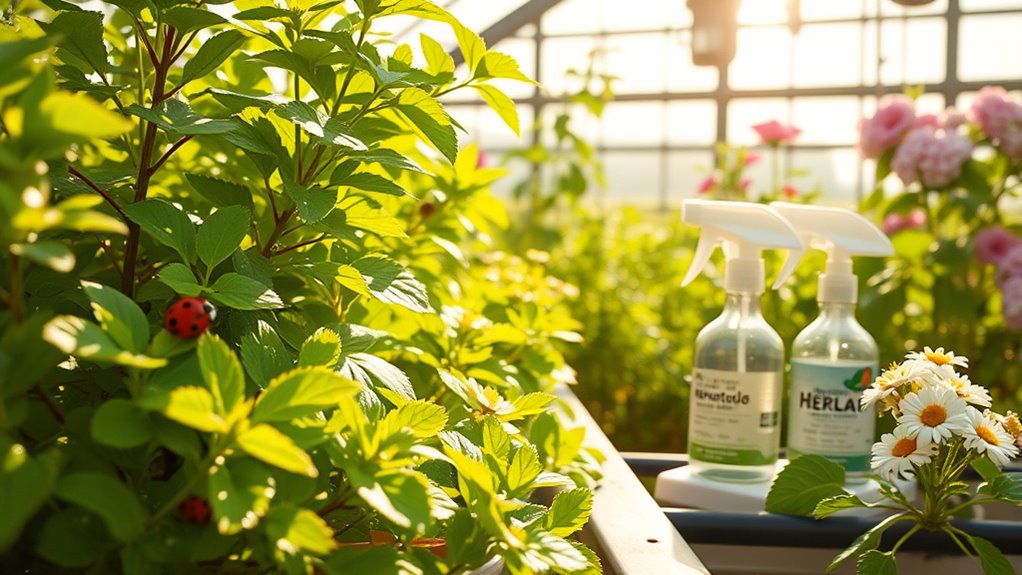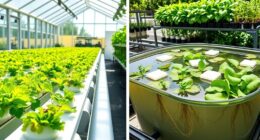To manage pests organically in your greenhouse, start with preventive measures like keeping the space clean and ventilated. Attract beneficial insects such as ladybugs and lacewings by planting diverse flowering herbs. Use natural remedies, including companion planting and homemade sprays, to deter unwanted pests. Implement biological controls like predatory insects and beneficial nematodes for effective pest management. Discover more about these strategies and their benefits for your greenhouse plants.
Key Takeaways
- Maintain cleanliness by regularly removing debris and cleaning surfaces to deter pests in the greenhouse.
- Introduce beneficial insects like ladybugs and lacewings to naturally control pest populations.
- Utilize companion planting strategies to enhance plant health and repel unwanted pests.
- Implement biological controls, such as parasitic insects and beneficial nematodes, for effective pest management.
- Use natural remedies like homemade sprays and barriers to protect plants from common pests.
Preventive Measures for Pest Control

When you prioritize preventive measures for pest control, you set the stage for a healthier greenhouse environment.
Start by maintaining cleanliness—regularly remove plant debris and clean surfaces to eliminate pest habitats. Guarantee proper ventilation to prevent humidity buildup, which fosters pests. Control temperatures to keep pests at bay, and manage moisture by avoiding overwatering to deter fungus gnats.
Regular inspections of plants help you catch infestations early, while pruning improves air circulation and reduces hiding spots. Healthy soil enhances plant resilience, so consider crop rotation to break pest cycles.
Finally, keep tools clean to prevent spreading pests. By implementing these strategies, you create an effective barrier against potential pest problems.
Attracting Beneficial Insects

How can you enhance your greenhouse's pest control strategy? One effective way is by attracting beneficial insects like ladybugs, lacewings, and parasitic wasps. These insects target specific pests, considerably reducing your reliance on pesticides.
Greenhouses provide perfect conditions for them, thanks to consistent temperature and humidity. To encourage these allies, plant flowering herbs and diverse plants that offer nectar and pollen.
You might also consider using banker plants, like purple flash pepper, to support their populations. Regularly monitor your greenhouse and release beneficial insects at the right time for ideal impact.
Utilizing Natural Remedies

Attracting beneficial insects sets a solid foundation for pest control, but complementing their presence with natural remedies can further enhance your greenhouse's defenses.
Incorporate companion planting by adding rosemary to repel cabbage loopers and petunias to deter aphids. You can use lemongrass to control mosquitoes and marigolds to manage nematodes.
Employ natural barriers like coffee grounds and crushed eggshells to keep slugs and snails at bay. Create homemade sprays using chili and garlic to repel pests, and neem oil to disrupt their life cycles. Additionally, maintaining healthy soil through compost and balanced nutrients is crucial for promoting strong plant immunity. By integrating these methods, you'll cultivate a thriving greenhouse environment while effectively managing pest issues.
Implementing Biological Controls

Implementing biological controls can considerably enhance your greenhouse's pest management strategy, as these methods harness the natural predators and parasites that keep pest populations in check.
You can introduce predatory insects like ladybugs and lacewings to tackle aphids, while parasitic insects such as *Encarsia formosa* can control whiteflies. For soil-dwelling pests, beneficial nematodes are highly effective.
Timing is vital; release these agents before pest populations surge. Guarantee ideal environmental conditions, like moderate temperatures and humidity, for their success.
Regular monitoring is essential to assess their effectiveness. Also, be mindful of pesticide compatibility, as some chemicals can harm your beneficial insects.
Companion Planting Strategies

Companion planting offers a natural way to enhance pest management in your greenhouse, as certain plant combinations can support each other's growth while repelling unwanted pests.
By pairing plants like marigolds with vegetables, you can deter aphids and nematodes, reducing reliance on chemical pesticides. Incorporating herbs such as basil not only boosts tomato flavor but also keeps pests at bay.
To optimize your space, group plants with similar nutrient needs and consider their growth habits. Remember to monitor plant health and pest populations regularly.
Frequently Asked Questions
How Can I Identify Pest Infestations in My Greenhouse?
To identify pest infestations in your greenhouse, conduct regular visual inspections.
Check the undersides of leaves for hidden pests and look for signs of damage, like yellowing or distorted growth.
Use sticky traps to monitor flying insects, placing them strategically throughout the space.
Consider using indicator plants that are vulnerable to specific pests, and keep an eye on them daily.
If you have the means, tech tools can help provide real-time pest data.
What Are the Signs of Beneficial Insects in My Greenhouse?
When it comes to spotting beneficial insects in your greenhouse, it's like finding a needle in a haystack, but you can do it!
Look for signs like the presence of eggs near pest populations, a noticeable drop in pests, or parasitized pests exhibiting puffy bodies.
Healthy plants and no chemical damage also indicate beneficial insects are at work.
Keep an eye out for these clues, and you'll know nature's helpers are on the job!
How Often Should I Inspect My Plants for Pests?
You should inspect your plants daily during peak pest seasons to catch any issues early.
In low-risk periods, you can reduce the inspections to every other day. New plants or sensitive crops need more frequent checks.
Keep an eye out for signs of damage, like yellowing leaves or spots.
Remember, consistent monitoring helps prevent infestations and guarantees your plants stay healthy and thriving.
Don't overlook changes in weather, as they can trigger increased pest activity!
Can I Use Chemical Pesticides Alongside Organic Methods?
You might think using chemical pesticides contradicts organic methods, but it's not that simple.
You can definitely use chemical pesticides alongside organic methods, especially through integrated pest management (IPM).
Just remember to prioritize natural options and use chemicals as a last resort. This approach can help you manage pests effectively while minimizing harm to the environment.
Always check the certification requirements if you're pursuing organic labeling to guarantee compliance.
What Should I Do if Pests Return After Treatment?
If pests return after treatment, don't panic.
First, inspect your plants closely to identify the specific pests. Adjust your treatment approach based on what you've observed.
Consider reapplying your chosen remedies or trying a different method. You might also want to improve your greenhouse environment by enhancing ventilation or reducing humidity.
Regular monitoring and maintaining a diverse plant population can help prevent future infestations.
Keep track of outcomes to refine your strategies.
Conclusion
By embracing organic pest control methods, you're not just protecting your greenhouse; you're cultivating a thriving ecosystem, much like a symphony of nature playing in harmony. Remember, preventive measures and beneficial insects are your allies, while natural remedies and biological controls offer powerful support. As you explore companion planting strategies, you'll find that nurturing your plants naturally brings a sense of fulfillment, proving that a healthy greenhouse can flourish with both care and creativity.









